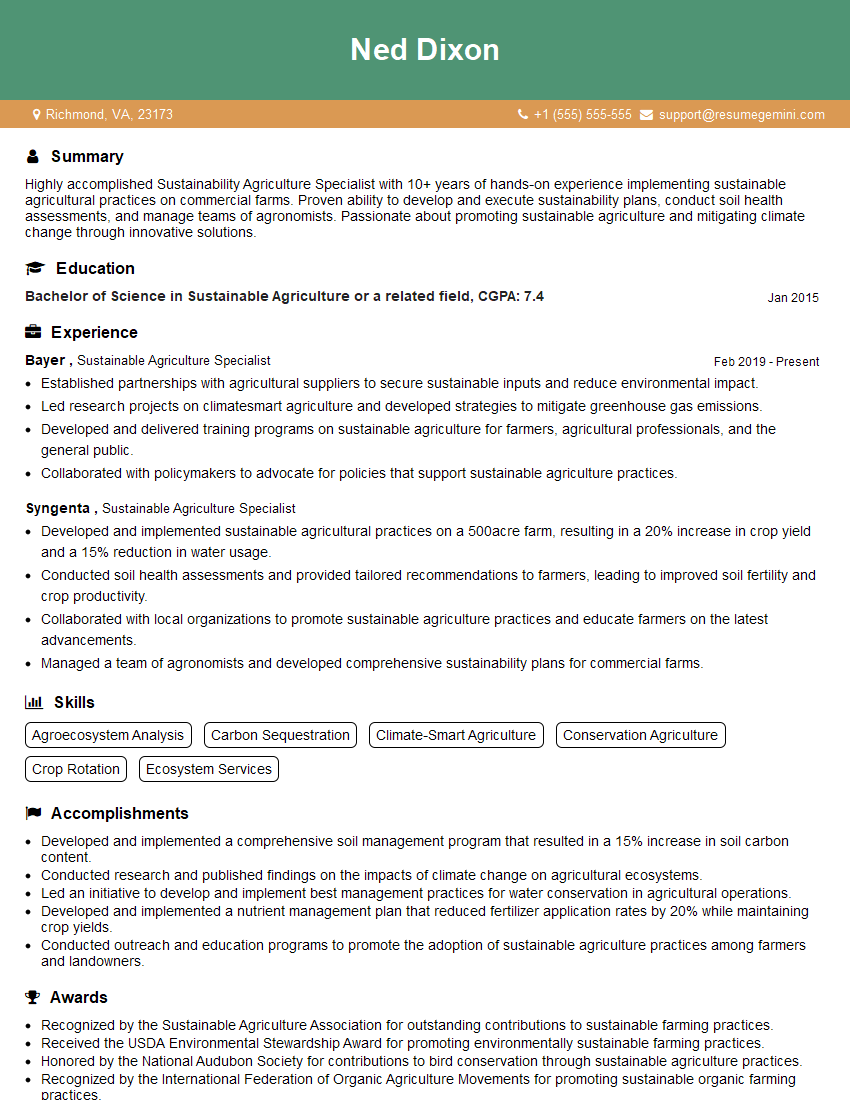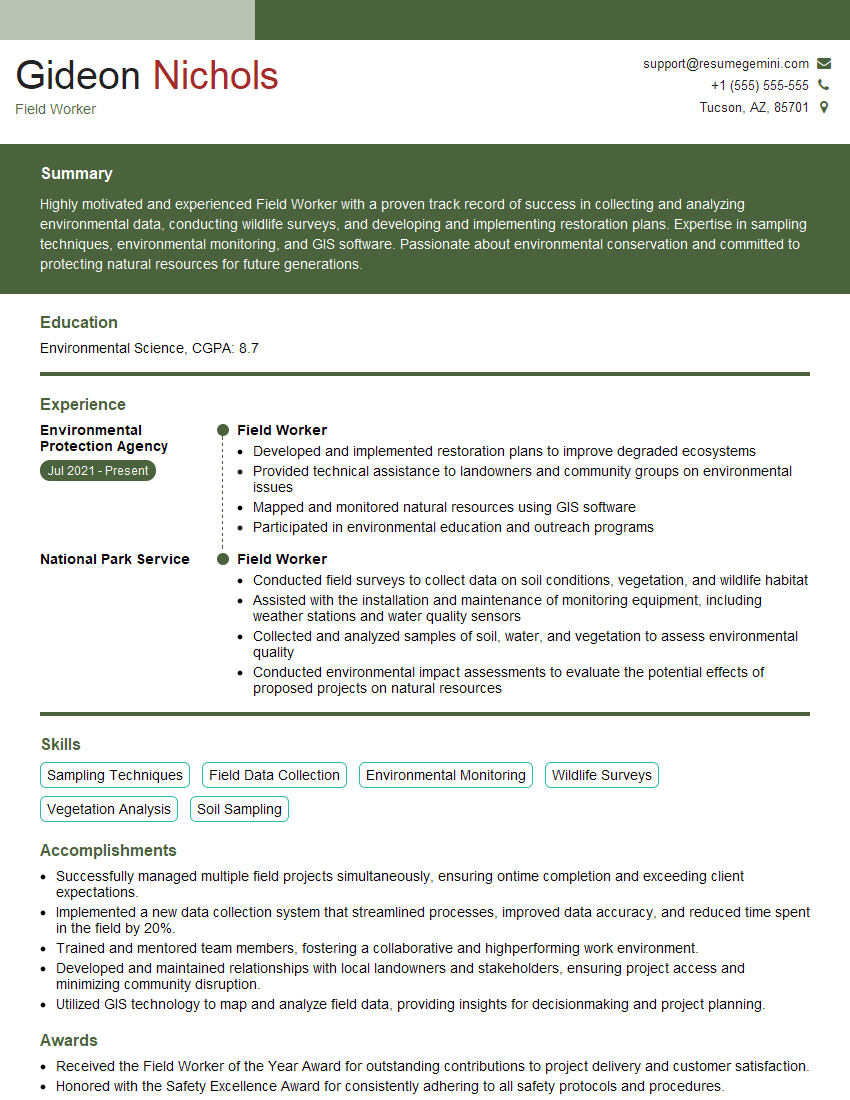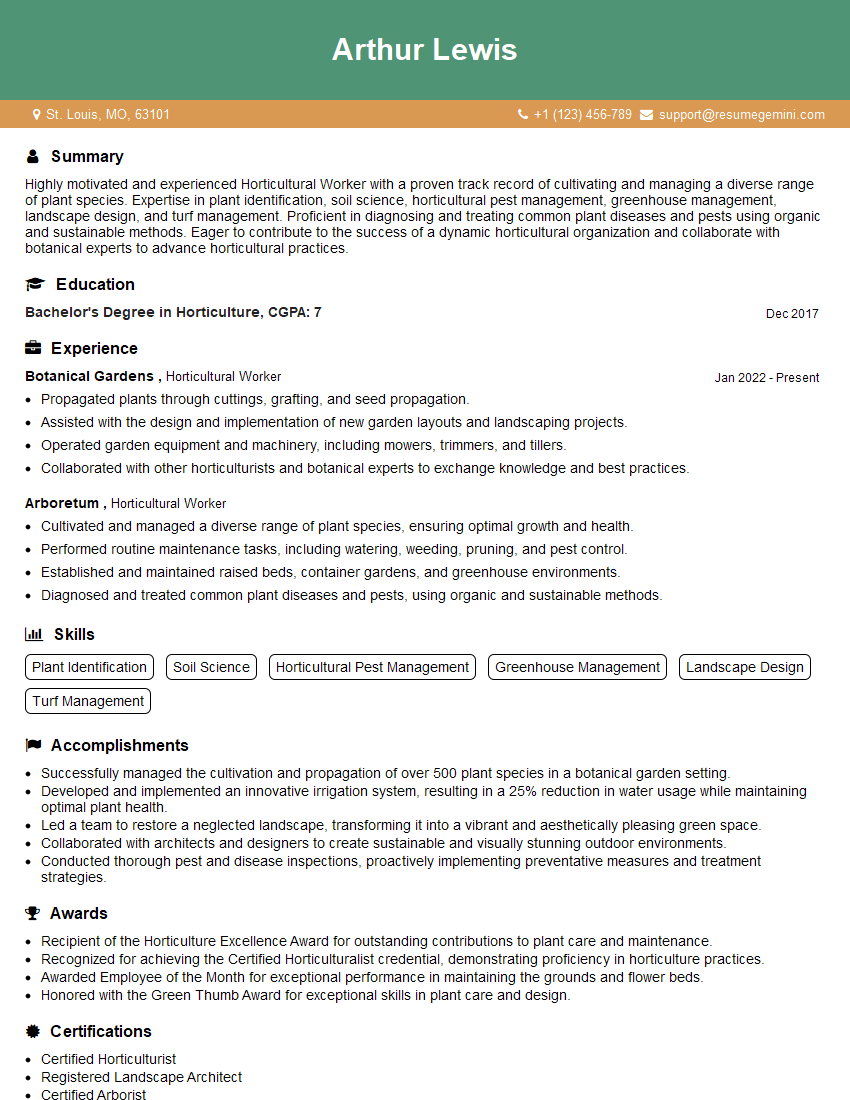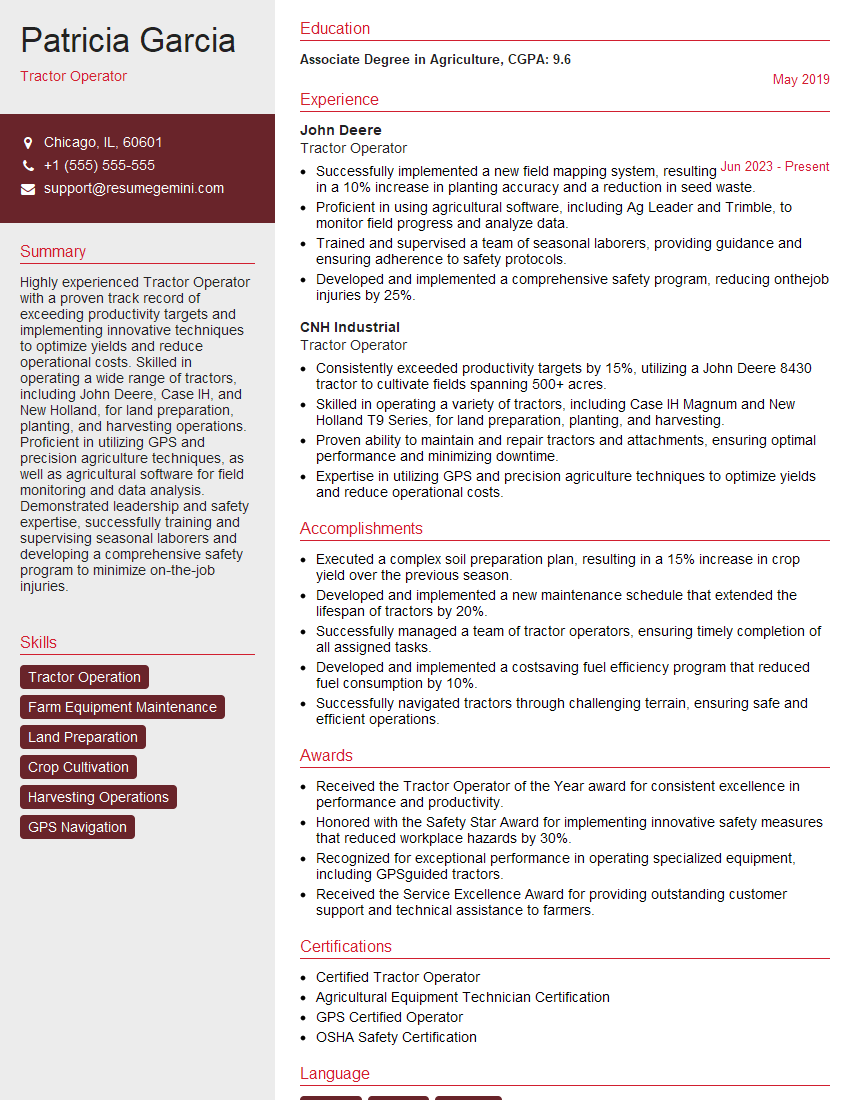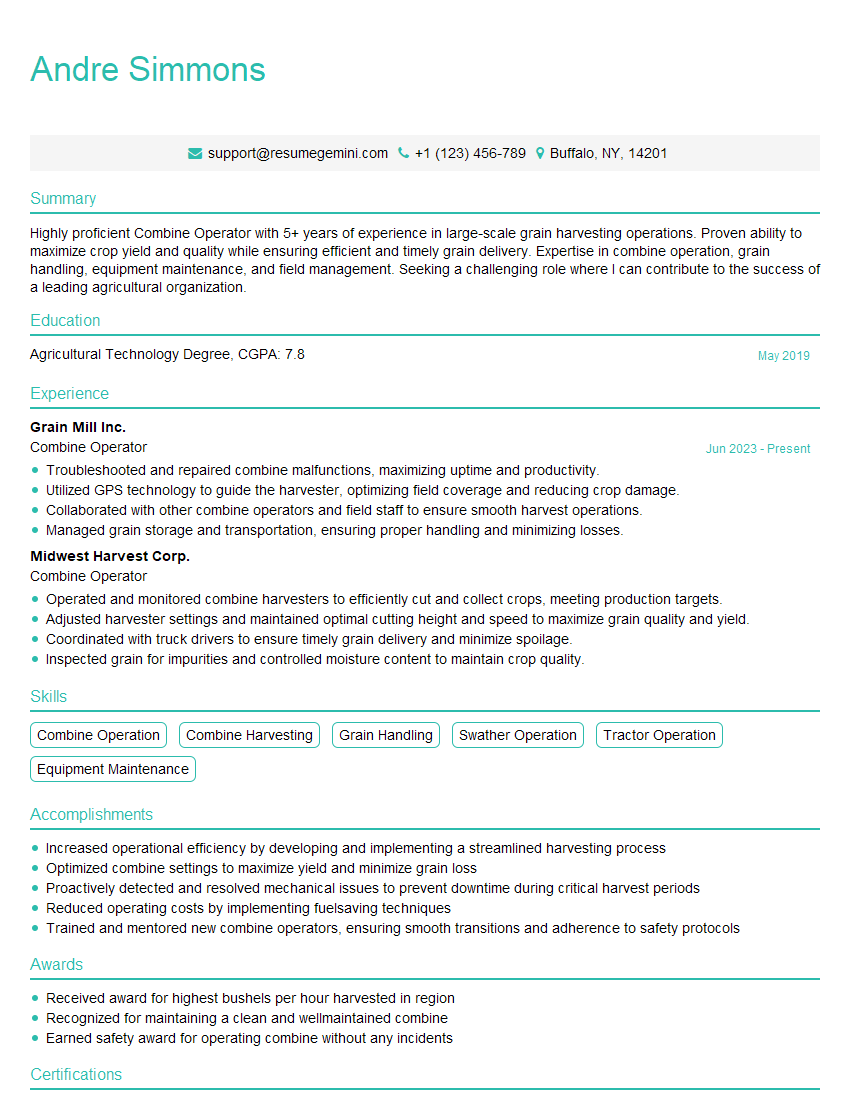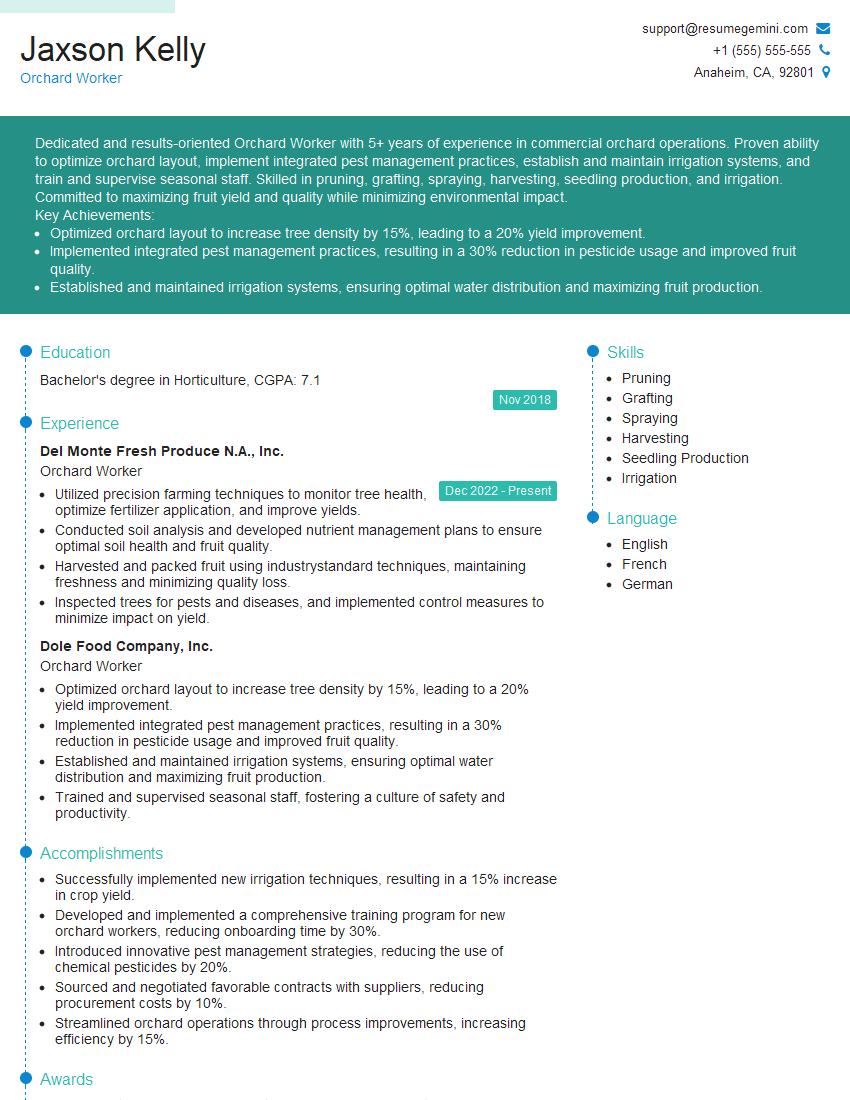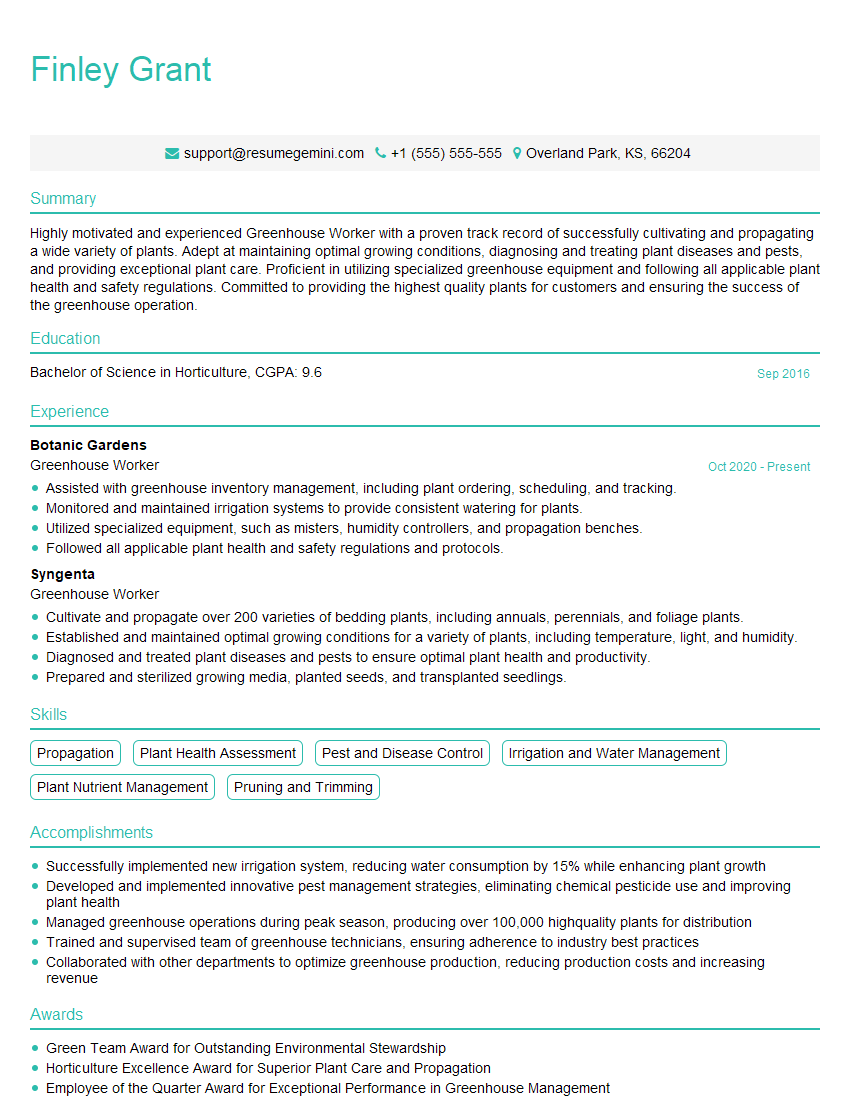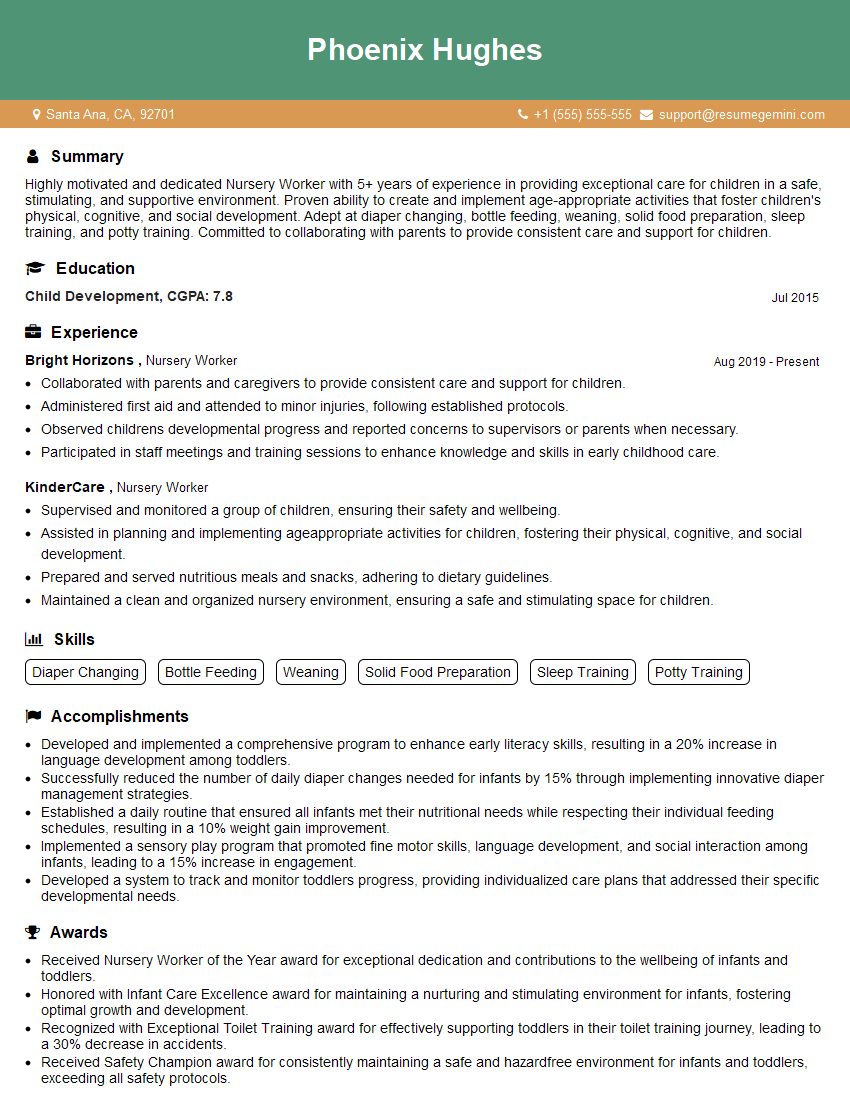Preparation is the key to success in any interview. In this post, we’ll explore crucial Basic Farming Skills interview questions and equip you with strategies to craft impactful answers. Whether you’re a beginner or a pro, these tips will elevate your preparation.
Questions Asked in Basic Farming Skills Interview
Q 1. Describe your experience with soil preparation techniques.
Soil preparation is crucial for successful crop production. It involves several techniques aimed at creating a seedbed that’s ideal for germination and root development. This includes:
Tilling: This breaks up compacted soil, improving aeration and water infiltration. Different tillage methods exist, from conventional plowing to no-till farming, each with its own advantages and disadvantages depending on soil type and crop. For example, no-till farming reduces soil erosion but might require more herbicide use.
Fertilizing: Adding essential nutrients to the soil before planting ensures healthy growth. Soil testing is vital to determine the specific nutrient needs of the soil and to avoid over-fertilization, which can harm the environment.
Weed Control: Removing weeds before planting prevents competition for resources. This can be done mechanically (e.g., tilling), chemically (e.g., herbicides), or manually (e.g., weeding).
Soil Amendment: Improving soil structure by adding organic matter like compost or manure. This enhances water retention, drainage, and nutrient availability. I’ve personally seen dramatic improvements in soil health after incorporating compost into clay soils, leading to better crop yields.
Q 2. What are the different types of irrigation systems and their advantages/disadvantages?
Irrigation systems deliver water to crops, crucial for optimal growth. Different systems have varying advantages and disadvantages:
Flood Irrigation: Flooding the entire field. It’s inexpensive but inefficient, leading to water wastage and potential soil erosion. I’ve witnessed this method in large-scale rice paddies, but it’s not sustainable in many contexts.
Drip Irrigation: Delivering water directly to plant roots through tubes. It’s highly efficient, minimizes water waste, and reduces weed growth. The initial cost is higher, but the long-term savings on water and labor make it worthwhile in many cases. This is my preferred system for most crops.
Sprinkler Irrigation: Using sprinklers to distribute water. It’s relatively inexpensive and easy to install, but less efficient than drip irrigation and can lead to water loss through evaporation.
Furrow Irrigation: Water flows in furrows between crop rows. Simple but less efficient than other methods, susceptible to water runoff and erosion.
Q 3. Explain the process of planting and harvesting a specific crop (e.g., corn, wheat).
Let’s take corn as an example. Planting corn involves:
Seed Selection: Choosing high-yielding, disease-resistant varieties suited to the local climate.
Planting: Using a planter to sow seeds at the correct depth and spacing. This often involves treating seeds with pesticides for added protection against soilborne diseases.
Crop Management: This includes irrigation, fertilization, weed control, and pest management throughout the growing season.
Harvesting: Typically done using a combine harvester, which mechanically removes the corn ears from the stalks. The timing is critical – harvesting too early reduces yield, while harvesting too late increases losses to spoilage or pests.
The process is similar for wheat, but the harvesting equipment differs, with combines specifically designed for wheat harvesting.
Q 4. How do you identify and address common crop diseases and pests?
Identifying and addressing crop diseases and pests requires a multi-pronged approach. This begins with regular field monitoring to detect early signs of infestation or disease. Methods include:
Visual Inspection: Regularly checking plants for unusual spots, discoloration, wilting, or insect activity.
Pest and Disease Identification: Using field guides, online resources, or consulting experts to accurately identify the problem.
Integrated Pest Management (IPM): Using a combination of methods, prioritizing cultural controls (e.g., crop rotation), biological controls (e.g., beneficial insects), and chemical controls (pesticides) only as a last resort. Over-reliance on pesticides can lead to resistance and environmental damage.
For instance, if I detect signs of corn borer infestation, I might first try biological control using parasitic wasps before resorting to insecticides.
Q 5. What are the best practices for fertilizing and managing soil nutrients?
Fertilizing and soil nutrient management are crucial for healthy crop growth. Best practices include:
Soil Testing: Analyzing soil samples to determine nutrient levels. This helps to avoid unnecessary fertilization and prevents nutrient imbalances.
Nutrient Balance: Applying fertilizers that provide the right proportions of nitrogen, phosphorus, and potassium (NPK). The specific NPK ratio varies depending on the crop and soil conditions.
Organic Farming Practices: Using organic fertilizers such as compost and manure to improve soil health and fertility. This improves soil structure and reduces the reliance on synthetic fertilizers.
Crop Rotation: Alternating different crops in a field to improve soil fertility and reduce pest and disease pressure. For example, legumes fix nitrogen in the soil, benefiting subsequent crops.
Q 6. Explain your experience with livestock handling and care.
My experience with livestock handling and care spans many years, encompassing various aspects, including:
Animal Handling Techniques: Employing safe and humane methods to move and manage animals, minimizing stress and risk of injury to both animals and handlers.
Feeding and Nutrition: Providing balanced diets appropriate to each animal’s age, breed, and physiological state, ensuring adequate nutrient intake for optimal health and productivity.
Health Management: Regular health checks, vaccination programs, and prompt treatment of illnesses and injuries. Biosecurity measures are crucial to prevent disease outbreaks.
Facility Management: Maintaining clean and safe housing, ensuring adequate ventilation, and implementing appropriate waste management practices.
I’ve personally worked with dairy cows, sheep, and poultry, learning the specific needs of each species.
Q 7. Describe your knowledge of different animal breeds and their characteristics.
Understanding different animal breeds and their characteristics is essential for effective livestock management. Breeds vary in terms of:
Productivity: Milk yield in dairy cattle, meat production in beef cattle, egg production in poultry, etc.
Disease Resistance: Some breeds are naturally more resistant to certain diseases.
Adaptability: Ability to thrive in specific environmental conditions (e.g., heat tolerance).
Temperament: Some breeds are known for their docile nature, while others can be more aggressive.
For example, Angus cattle are known for their high-quality beef and adaptability to various climates, while Jersey cows are prized for their high butterfat milk production. This knowledge helps in making informed decisions about breed selection to match specific production goals and environmental conditions.
Q 8. How do you monitor animal health and address common health issues?
Monitoring animal health is crucial for maintaining productivity and preventing disease outbreaks. It involves regular observation, preventative measures, and prompt response to any signs of illness. Think of it like a regular health check-up for your livestock.
- Regular Observation: Daily visual checks are essential. Look for changes in behavior (lethargy, loss of appetite), physical appearance (discharge, lameness, unusual droppings), and body temperature. For example, a cow consistently refusing feed could indicate a digestive problem.
- Preventative Measures: This includes vaccination programs tailored to the specific animals and their environment, providing clean water and proper nutrition, and maintaining hygienic living conditions. Regular deworming is also vital.
- Addressing Health Issues: Prompt identification is key. If you notice anything unusual, isolate the animal to prevent spread, contact a veterinarian immediately, and follow their advice carefully. Keeping detailed records of treatments and responses aids future management.
- Record Keeping: Maintain a detailed record of each animal’s health history, including vaccinations, treatments, and any observed symptoms. This allows you to track trends and make informed decisions about animal care.
Q 9. What safety measures do you follow when operating farm machinery?
Safety is paramount when operating farm machinery. A single mistake can lead to serious injury or even death. Following established safety protocols is not just a good idea; it’s a necessity.
- Pre-operation Checks: Before starting any machinery, thoroughly inspect it for any damage or malfunction. Check fluid levels (oil, coolant), tire pressure, and ensure all safety features (guards, lights, brakes) are functioning correctly.
- Personal Protective Equipment (PPE): Always wear appropriate PPE, including sturdy footwear, safety glasses, hearing protection, and a high-visibility vest. Depending on the machinery, additional protective gear might be necessary.
- Safe Operating Procedures: Follow all manufacturer’s instructions carefully. Never operate machinery under the influence of alcohol or drugs. Be aware of your surroundings, especially when operating near slopes, water bodies, or other hazards.
- Maintenance and Repair: Regularly maintain and repair equipment to prevent malfunctions. Never attempt repairs while the machine is running. Always disconnect power sources before undertaking any maintenance or repair work.
- Emergency Procedures: Know the location of emergency shut-off switches and how to use them. Be prepared to react in case of a malfunction or accident.
Q 10. Explain your experience with maintaining and repairing farm equipment.
Maintaining and repairing farm equipment is a crucial skill. Regular maintenance prevents costly breakdowns and ensures efficient operation. My experience encompasses both preventative maintenance and troubleshooting repairs.
For instance, I’ve regularly serviced tractors, including oil changes, filter replacements, and adjustments of belts and chains. I’ve also successfully repaired various pieces of equipment, from fixing a broken plow to troubleshooting electrical issues in a combine harvester. Knowing how to weld, use basic hand tools, and diagnose mechanical problems is vital. I rely on both manufacturer manuals and online resources for detailed instructions and diagrams whenever needed.
I also believe in preventative maintenance. Regular cleaning and lubrication of machinery prevents premature wear and tear, extending its lifespan and reducing the need for costly repairs.
Q 11. How do you ensure efficient water management on a farm?
Efficient water management is crucial for sustainable farming. It involves optimizing water use, minimizing waste, and protecting water resources. Think of it like carefully managing a precious resource.
- Irrigation Techniques: Implementing appropriate irrigation methods such as drip irrigation or sprinkler systems, tailored to the specific crop needs, reduces water waste compared to flood irrigation.
- Water Storage: Constructing reservoirs or utilizing rainwater harvesting techniques helps store water during periods of abundance for use during dry spells.
- Water Monitoring: Regularly monitoring soil moisture levels helps determine the precise amount of water needed, preventing overwatering or underwatering.
- Water Quality: Ensuring good water quality is important to avoid introducing contaminants to the soil or crops.
- Conservation Practices: Implementing practices such as mulching, which retains soil moisture, reduces the need for irrigation.
Q 12. Describe your experience with crop rotation and its benefits.
Crop rotation is the practice of planting different types of crops in a planned sequence on the same piece of land over several growing seasons. It’s a fundamental principle of sustainable agriculture.
- Pest and Disease Control: Rotating crops disrupts the life cycles of pests and diseases, reducing their populations and preventing outbreaks. For example, planting a legume after a grain crop can reduce nematode infestations.
- Soil Health Improvement: Different crops have different nutrient requirements. Rotating crops helps maintain soil fertility and prevents nutrient depletion. Legumes, for instance, fix nitrogen in the soil, benefiting subsequent crops.
- Weed Control: Certain crops can suppress weed growth, and rotating crops can help manage weed populations.
- Erosion Control: Cover crops, often part of a rotation plan, can improve soil structure and reduce erosion.
- Example: A common rotation might involve corn, soybeans, and wheat in a three-year cycle. Corn is a heavy feeder, soybeans fix nitrogen, and wheat requires moderate nutrients.
Q 13. What are the principles of integrated pest management (IPM)?
Integrated Pest Management (IPM) is a holistic approach to pest control that combines various strategies to minimize pest damage while minimizing environmental impact. It’s about finding a balance between pest control and environmental protection.
- Monitoring: Regular monitoring of pests and their damage is crucial for timely intervention. This involves visually inspecting crops and using traps or other monitoring tools.
- Prevention: Preventative measures, such as crop rotation, selecting pest-resistant varieties, and maintaining healthy soil, reduce pest pressure.
- Biological Control: Utilizing natural enemies of pests, such as beneficial insects or nematodes, can help control pest populations.
- Cultural Control: Using farming practices to make the environment less suitable for pests, such as adjusting planting times or using proper irrigation techniques.
- Chemical Control: Using pesticides only as a last resort, and choosing the least toxic option, targeting specific pests only when necessary.
Q 14. How do you ensure food safety and hygiene standards are met?
Ensuring food safety and hygiene is paramount throughout the entire farming process, from field to table. It involves careful planning and consistent practices.
- Cleanliness: Maintaining clean equipment, facilities, and work areas is crucial. Regular sanitation of storage areas is essential to prevent contamination.
- Pest Control: Implementing effective pest control measures, following IPM principles, prevents pests from contaminating crops and livestock.
- Proper Handling and Storage: Crops and livestock should be handled and stored correctly to prevent spoilage and contamination. This involves following temperature guidelines and using appropriate storage containers.
- Hygiene Practices: Farm workers should maintain high hygiene standards by wearing clean clothing and practicing proper handwashing.
- Traceability: Keeping detailed records allows tracing the origin and handling of food products, aiding in identifying potential contamination sources.
- Compliance: Adhering to all relevant food safety regulations and guidelines is crucial. Understanding and implementing relevant standards (e.g., HACCP) is fundamental.
Q 15. Explain your understanding of sustainable farming practices.
Sustainable farming practices are all about balancing environmental responsibility, economic viability, and social equity. It’s about producing food and fiber in a way that doesn’t deplete our natural resources or harm the environment, while also ensuring the farmers and communities involved are thriving.
- Reduced Chemical Inputs: This involves minimizing or eliminating the use of synthetic pesticides and fertilizers. Instead, we focus on techniques like crop rotation, cover cropping, and integrated pest management to naturally enhance soil health and control pests.
- Soil Health Management: Healthy soil is fundamental. We use practices like no-till farming, cover cropping, and composting to improve soil structure, water retention, and nutrient cycling. Think of it like building a strong foundation for your crops.
- Water Conservation: Efficient irrigation methods like drip irrigation are crucial, reducing water waste and preserving groundwater supplies. We also carefully monitor soil moisture to irrigate only when necessary.
- Biodiversity: Promoting biodiversity on the farm helps maintain ecological balance and resilience. This includes planting diverse crops, creating wildlife habitats, and avoiding monocultures (planting only one crop).
- Energy Efficiency: We look for ways to reduce energy consumption on the farm. This could include using renewable energy sources like solar power, improving equipment efficiency, and reducing transportation distances.
For example, on my previous farm, we implemented a no-till system, which drastically reduced soil erosion and improved water retention. This resulted in higher yields and reduced our need for irrigation.
Career Expert Tips:
- Ace those interviews! Prepare effectively by reviewing the Top 50 Most Common Interview Questions on ResumeGemini.
- Navigate your job search with confidence! Explore a wide range of Career Tips on ResumeGemini. Learn about common challenges and recommendations to overcome them.
- Craft the perfect resume! Master the Art of Resume Writing with ResumeGemini’s guide. Showcase your unique qualifications and achievements effectively.
- Don’t miss out on holiday savings! Build your dream resume with ResumeGemini’s ATS optimized templates.
Q 16. What is your experience with record-keeping and data management in agriculture?
Record-keeping and data management are essential for efficient and profitable farming. I utilize a combination of software and physical records to track various aspects of my operations.
- Yield Tracking: I meticulously record yields per acre for each crop, noting variations across different fields or planting dates. This data helps me identify areas for improvement and optimize planting strategies.
- Input Costs: I keep detailed records of all inputs, including seeds, fertilizers, pesticides, fuel, and labor. This allows for accurate cost analysis and informed decision-making.
- Weather Data: I track rainfall, temperature, and other weather patterns to understand their impact on crop growth and adjust management practices accordingly. This can be done with on-farm weather stations or through online weather services.
- Soil Testing: Regular soil testing is crucial for determining nutrient levels and adjusting fertilizer applications. I maintain a record of soil test results over time to monitor soil health trends.
I use a farm management software to digitally store and analyze this data. This software allows me to generate reports, track trends, and make data-driven decisions to improve efficiency and profitability. For example, by analyzing yield data over several years, I was able to identify a specific field that consistently underperformed and then address the underlying issue, such as poor drainage.
Q 17. How do you handle challenging weather conditions during planting or harvesting?
Challenging weather conditions can significantly impact crop yields. My approach involves a combination of preventative measures, timely adjustments, and risk mitigation strategies.
- Crop Selection: Choosing crop varieties that are adapted to local weather conditions is crucial. This involves selecting drought-resistant crops in arid regions or frost-tolerant varieties in areas prone to freezing temperatures.
- Weather Monitoring: Closely monitoring weather forecasts allows for proactive adjustments. This could involve delaying planting or harvesting to avoid extreme weather events or implementing protective measures like frost covers.
- Irrigation Management: Efficient irrigation systems are essential for mitigating drought conditions. Drip irrigation helps deliver water directly to plant roots, conserving water and reducing stress during dry spells.
- Insurance: Crop insurance can provide a safety net against unpredictable weather events, protecting against potential financial losses.
One time, a sudden hailstorm threatened my harvest. By quickly mobilizing my team and utilizing protective netting, we minimized the damage significantly, reducing the impact on yield and quality.
Q 18. Describe your experience with using GPS technology in farming.
GPS technology has revolutionized farming, offering precision and efficiency. My experience with GPS includes using it for various tasks.
- Precision Planting: GPS-guided planters ensure consistent seed spacing and depth, optimizing plant establishment and maximizing yield potential. This reduces overlaps and gaps in planting, leading to better resource utilization.
- Variable Rate Technology (VRT): VRT, guided by GPS data, allows for precise application of inputs such as fertilizers and pesticides based on the specific needs of each area of the field. This minimizes waste and optimizes resource use, benefiting both the environment and the bottom line.
- Auto-Steer: Auto-steer systems, guided by GPS, allow for hands-free operation of tractors and other machinery. This reduces operator fatigue, improves accuracy, and increases efficiency.
- Field Mapping: GPS allows for precise mapping of fields, facilitating yield monitoring, soil sampling, and other precision agriculture tasks. This helps in creating management zones and addressing field-specific needs.
For example, using GPS-guided machinery, we were able to reduce fertilizer application by 15% without compromising yield, leading to significant cost savings and a reduced environmental footprint.
Q 19. How do you manage weed control in your farming operations?
Weed control is a critical aspect of farming. My approach is an integrated one, combining preventative and corrective measures to minimize weed pressure without relying solely on herbicides.
- Preventative Measures: These include practices such as crop rotation, cover cropping, and using clean seed. Crop rotation disrupts the weed life cycle, while cover crops compete with weeds for resources. Clean seed prevents introducing weed seeds into the field.
- Mechanical Weed Control: This involves using tools like cultivators and hoes to physically remove weeds. This is particularly effective for early-season weed control.
- Targeted Herbicide Application: In some cases, herbicides may be necessary, but I favor targeted applications to minimize environmental impact. This might involve using spot spraying or pre-emergent herbicides.
- Biological Control: Exploring natural enemies of specific weeds can be a sustainable approach to weed management. For instance, certain insects can effectively control certain weed species.
In one instance, by implementing a cover cropping strategy, we significantly reduced weed pressure, ultimately cutting herbicide use by over 30%.
Q 20. What is your knowledge of different types of fertilizers and their application?
Different fertilizers offer different nutrient profiles and release characteristics. Understanding these differences is vital for effective fertilization.
- Inorganic Fertilizers: These are synthetically produced and contain specific ratios of nitrogen (N), phosphorus (P), and potassium (K), often represented as NPK ratios (e.g., 10-10-10). They offer a quick release of nutrients, but overuse can damage soil health.
- Organic Fertilizers: These are derived from natural sources such as manure, compost, and bone meal. They provide a slower release of nutrients, improving soil health over time. However, their nutrient content can be less predictable.
- Slow-Release Fertilizers: These are designed to release nutrients gradually, minimizing nutrient loss and leaching into the environment. This reduces the frequency of fertilizer application.
Soil testing determines the specific nutrient needs of the crop and soil, guiding fertilizer selection. For example, a soil test may indicate a deficiency in phosphorus, necessitating the use of a fertilizer with a higher P content. I always prioritize soil health, selecting fertilizer types and application methods that minimize environmental impact.
Q 21. Explain your experience with post-harvest handling and storage of crops.
Post-harvest handling and storage are critical for maintaining crop quality and minimizing losses. Proper procedures ensure the marketability and longevity of the harvest.
- Careful Harvesting: Harvesting techniques should minimize damage to the crops. This includes using appropriate machinery and handling procedures.
- Cleaning and Grading: Removing debris and grading produce based on size and quality improves marketability.
- Drying and Curing: For some crops, proper drying and curing are essential to prevent spoilage. This is often a crucial step for grain crops and some fruits and vegetables.
- Storage Conditions: Maintaining optimal temperature and humidity levels during storage is vital to preserving quality and preventing spoilage. This may involve refrigerated storage, controlled atmosphere storage, or other methods depending on the crop.
- Pest and Disease Management: Storage facilities must be kept clean and free from pests and diseases to prevent spoilage and contamination.
For instance, during the harvest of tomatoes, careful handling prevents bruising. Following this with appropriate sorting and storing at the right temperature ensures long shelf life and avoids considerable losses.
Q 22. How do you ensure the quality and yield of your crops?
Ensuring high-quality crop yields involves a multifaceted approach that begins long before planting and continues through harvest. It’s like baking a cake – you need the right ingredients, the perfect recipe, and careful execution.
Soil Health: Regular soil testing is crucial. It tells us the nutrient levels (nitrogen, phosphorus, potassium, etc.) and pH, allowing us to amend the soil with fertilizers and/or lime to optimize conditions for the specific crop. Think of it as providing the cake batter with the best possible ingredients.
Seed Selection: Choosing high-quality, disease-resistant seeds from reputable suppliers is paramount. This is like selecting premium ingredients for your cake.
Planting Techniques: Proper planting depth, spacing, and timing are essential for maximizing sunlight and water absorption. We adjust these based on the crop’s needs and local climate conditions – the proper baking temperature and time for the best result.
Pest and Disease Management: Integrated Pest Management (IPM) strategies are vital. This involves monitoring for pests and diseases and using preventative measures like crop rotation, companion planting, and biological controls before resorting to chemical pesticides, minimizing environmental impact and ensuring consumer safety. Think of this as preventing the cake from getting spoiled.
Irrigation and Water Management: Efficient irrigation techniques, such as drip irrigation or furrow irrigation, are used to provide the right amount of water at the right time. Overwatering or underwatering can drastically affect yield and quality. This is similar to precisely measuring the liquid ingredients in the cake recipe.
Harvesting and Post-Harvest Handling: Careful harvesting and proper storage techniques minimize losses and maintain quality. This final stage ensures the cake is perfectly presented and enjoyed.
Q 23. What is your experience with using precision farming techniques?
Precision farming techniques have revolutionized how we manage our farms. I have extensive experience using GPS-guided machinery for planting, fertilizing, and spraying. This allows for precise application of inputs, minimizing waste and maximizing efficiency. For example, variable-rate technology allows us to adjust fertilizer application based on the soil’s nutrient needs, mapped through soil sampling and analysis.
Furthermore, I’ve utilized yield monitoring sensors during harvest to collect data on crop performance across different zones in the field. This data helps us fine-tune our management practices for the following season. We analyze this data alongside weather data, soil data, and planting information to identify areas for improvement and ultimately maximize profits.
I’m also familiar with using remote sensing technologies, such as drones equipped with multispectral cameras, to monitor crop health and identify stress areas early on. This allows for proactive intervention, preventing significant yield losses.
Q 24. How do you address challenges related to labor management on a farm?
Labor management is crucial for a successful farm. It involves careful planning, efficient scheduling, and a strong emphasis on employee training and safety. We begin by accurately estimating labor needs for different stages of production, from planting to harvesting.
Seasonal Workers: I have experience working with both full-time employees and seasonal workers, ensuring fair wages and compliance with all labor laws. This involves creating clear job descriptions and providing adequate training.
Technology: We utilize technology to improve efficiency and reduce the physical demands on our workforce. This includes using automated equipment wherever possible and providing workers with tools and equipment that minimize strain.
Teamwork and Communication: I foster a positive and collaborative work environment by encouraging open communication and teamwork. Regular meetings and feedback sessions help resolve any issues proactively.
Employee Retention: By providing fair wages, benefits, and opportunities for professional development, we can keep a skilled and experienced workforce.
Q 25. Describe your understanding of farm budgeting and financial management.
Farm budgeting and financial management are crucial for long-term success. It’s not just about knowing how much you’re earning; it’s about understanding all the costs involved and planning strategically.
Budgeting: This involves creating a detailed plan that outlines projected income and expenses for the entire farming cycle. This budget includes costs for seeds, fertilizers, pesticides, labor, equipment maintenance, and marketing.
Financial Record Keeping: Maintaining accurate and up-to-date financial records is essential. This helps in tracking income, expenses, and profitability, and aids in tax preparation.
Cost Analysis: We regularly analyze our costs to identify areas for potential savings. For instance, optimizing irrigation systems can significantly reduce water expenses.
Profitability Analysis: We assess the profitability of different crops and farming practices, identifying those that provide the best return on investment. This helps in making informed decisions on what to plant and how to manage resources.
Financial Forecasting: Looking ahead and creating financial forecasts allows us to anticipate potential challenges and make adjustments in our budget to mitigate risk. This is especially helpful during times of market uncertainty.
Q 26. Explain your knowledge of agricultural regulations and compliance.
Agricultural regulations and compliance are paramount for ensuring the safety and quality of our products and protecting the environment. I am well-versed in local, state, and federal regulations concerning pesticide use, water quality, and food safety.
Pesticide Use: I always follow label instructions when using pesticides and adhere to all regulations concerning application rates, safety precautions, and storage. I maintain meticulous records of pesticide use as required by law.
Water Quality: I understand and comply with regulations concerning water usage and runoff management, taking steps to minimize pollution and protect water resources.
Food Safety: I am familiar with Good Agricultural Practices (GAPs) and follow all procedures to ensure food safety from field to market. This includes proper sanitation practices and record-keeping.
Regulations Updates: I stay up-to-date on changes to agricultural regulations and ensure our farm operates in full compliance. We attend workshops and training sessions to ensure continued compliance.
Q 27. How do you contribute to a positive and safe work environment on a farm?
A positive and safe work environment is crucial for both productivity and employee well-being. I foster a culture of respect, teamwork, and safety through several key strategies.
Safety Training: Regular safety training is provided to all employees, covering topics such as equipment operation, handling hazardous materials, and emergency procedures.
Safety Equipment: I ensure that all employees have access to and are trained to use appropriate personal protective equipment (PPE), including safety glasses, gloves, and hearing protection.
Regular Inspections: Regular safety inspections of equipment and work areas are conducted to identify and address potential hazards before they lead to incidents.
Open Communication: I encourage open communication and feedback from employees regarding safety concerns and work conditions.
Positive Work Environment: I promote a positive work environment by valuing employees’ contributions and recognizing their hard work.
Q 28. Describe your problem-solving skills in a farm setting.
Problem-solving is an everyday aspect of farming. My approach is methodical and relies on a combination of experience, data analysis, and creativity.
Identify the Problem: The first step is to clearly define the problem. Is it a pest infestation, equipment malfunction, or soil nutrient deficiency? Accurate identification is critical for effective problem-solving.
Gather Information: I collect data relevant to the problem. This could involve soil testing, crop scouting, reviewing weather patterns, or consulting with other farmers or agricultural experts.
Develop Solutions: Based on the gathered information, I brainstorm potential solutions. I consider both short-term and long-term solutions, weighing their costs and benefits.
Implement and Evaluate: I implement the chosen solution and carefully monitor its effectiveness. I may need to adjust the solution based on the results. For instance, if a pesticide isn’t effective against a specific pest, we’ll research alternative methods, possibly biological controls.
Document Findings: I meticulously document the problem, the solution, and the outcome. This information is invaluable for future reference and helps us learn from our experiences.
Key Topics to Learn for Basic Farming Skills Interview
- Soil Management: Understanding soil types, nutrient requirements, soil testing, and sustainable soil practices. Practical application: Describing experience with soil preparation, fertilization, and amendment techniques.
- Crop Production: Knowledge of planting methods, crop rotation, pest and disease management, irrigation techniques, and harvesting procedures. Practical application: Explaining your experience with specific crops, including planting density, weed control, and yield optimization.
- Livestock Management (if applicable): Understanding animal husbandry, feeding, breeding, health management, and record-keeping for various livestock. Practical application: Detailing experience with animal care, including feeding regimens, disease prevention, and handling techniques.
- Equipment Operation & Maintenance: Safe and efficient operation of farm machinery (tractors, harvesters, etc.) and basic maintenance procedures. Practical application: Describing experience operating specific machinery and performing basic repairs or maintenance.
- Sustainable Farming Practices: Knowledge of environmentally friendly farming techniques, such as integrated pest management, water conservation, and reducing carbon footprint. Practical application: Explaining how you have incorporated sustainable practices into your farming activities.
- Farm Safety and Regulations: Awareness of farm safety regulations, hazard identification, and risk mitigation strategies. Practical application: Demonstrating an understanding of safe work practices and compliance with relevant regulations.
- Record Keeping and Financial Management: Maintaining accurate records of expenses, yields, and other relevant data for farm profitability. Practical application: Explaining how you track expenses and income to manage farm finances effectively.
Next Steps
Mastering basic farming skills is crucial for career advancement in the agricultural sector. A strong understanding of these topics will significantly improve your interview performance and open doors to exciting opportunities. To enhance your job prospects, focus on creating an ATS-friendly resume that effectively showcases your skills and experience. ResumeGemini is a trusted resource that can help you build a professional and impactful resume. Examples of resumes tailored to Basic Farming Skills are available to guide you in creating a compelling application. Investing time in crafting a high-quality resume is an investment in your future career success.
Explore more articles
Users Rating of Our Blogs
Share Your Experience
We value your feedback! Please rate our content and share your thoughts (optional).
What Readers Say About Our Blog
Hello,
We found issues with your domain’s email setup that may be sending your messages to spam or blocking them completely. InboxShield Mini shows you how to fix it in minutes — no tech skills required.
Scan your domain now for details: https://inboxshield-mini.com/
— Adam @ InboxShield Mini
Reply STOP to unsubscribe
Hi, are you owner of interviewgemini.com? What if I told you I could help you find extra time in your schedule, reconnect with leads you didn’t even realize you missed, and bring in more “I want to work with you” conversations, without increasing your ad spend or hiring a full-time employee?
All with a flexible, budget-friendly service that could easily pay for itself. Sounds good?
Would it be nice to jump on a quick 10-minute call so I can show you exactly how we make this work?
Best,
Hapei
Marketing Director
Hey, I know you’re the owner of interviewgemini.com. I’ll be quick.
Fundraising for your business is tough and time-consuming. We make it easier by guaranteeing two private investor meetings each month, for six months. No demos, no pitch events – just direct introductions to active investors matched to your startup.
If youR17;re raising, this could help you build real momentum. Want me to send more info?
Hi, I represent an SEO company that specialises in getting you AI citations and higher rankings on Google. I’d like to offer you a 100% free SEO audit for your website. Would you be interested?
Hi, I represent an SEO company that specialises in getting you AI citations and higher rankings on Google. I’d like to offer you a 100% free SEO audit for your website. Would you be interested?
good

